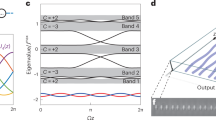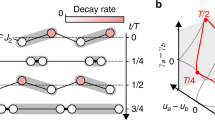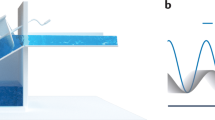Abstract
The topological protection of wave transport, originally observed in the context of the quantum Hall effect in two-dimensional electron gases1, has been shown to apply broadly to a range of physical platforms, including photonics2,3,4,5, ultracold atoms in optical lattices6,7,8 and others9,10,11,12. That said, the behaviour of such systems can be very different from the electronic case, particularly when interparticle interactions or nonlinearity play a major role13,14,15,16,17,18,19,20,21,22. A Thouless pump23 is a one-dimensional model that captures the topological quantization of transport in the quantum Hall effect using the notion of dimensional reduction: an adiabatically, time-varying potential mathematically maps onto a momentum coordinate in a conceptual second dimension24,25,26,27,28,29,30,31,32,33,34. Importantly, quantization assumes uniformly filled electron bands below a Fermi energy, or an equivalent occupation for non-equilibrium bosonic systems. Here we theoretically propose and experimentally demonstrate quantized nonlinear Thouless pumping of photons with a band that is decidedly not uniformly occupied. In our system, nonlinearity acts to quantize transport via soliton formation and spontaneous symmetry-breaking bifurcations. Quantization follows from the fact that the instantaneous soliton solutions centred upon a given unit cell are identical after each pump cycle, up to translation invariance; this is an entirely different mechanism from traditional Thouless pumping. This result shows that nonlinearity and interparticle interactions can induce quantized transport and topological behaviour without a linear counterpart.
This is a preview of subscription content, access via your institution
Access options
Access Nature and 54 other Nature Portfolio journals
Get Nature+, our best-value online-access subscription
$29.99 / 30 days
cancel any time
Subscribe to this journal
Receive 51 print issues and online access
$199.00 per year
only $3.90 per issue
Buy this article
- Purchase on Springer Link
- Instant access to full article PDF
Prices may be subject to local taxes which are calculated during checkout




Similar content being viewed by others
Data availability
The data that support the findings of this study are available from the corresponding author on reasonable request.
References
Klitzing, K. V., Dorda, G. & Pepper, M. New method for high-accuracy determination of the fine-structure constant based on quantized Hall resistance. Phys. Rev. Lett. 45, 494–497 (1980).
Raghu, S. & Haldane, F. D. M. Analogs of quantum-Hall-effect edge states in photonic crystals. Phys. Rev. A 78, 033834 (2008).
Wang, Z., Chong, Y., Joannopoulos, J. D. & Soljai, M. Observation of unidirectional backscattering-immune topological electromagnetic states. Nature 461, 772–775 (2009).
Rechtsman, M. C. et al. Photonic Floquet topological insulators. Nature 496, 196 (2013).
Hafezi, M., Mittal, S., Fan, J., Migdall, A. & Taylor, J. M. Imaging topological edge states in silicon photonics. Nat. Photon. 7, 1001 (2013).
Atala, M. et al. Direct measurement of the Zak phase in topological Bloch bands. Nat. Phys. 9, 795−800 (2013).
Jotzu, G. et al. Experimental realization of the topological Haldane model with ultracold fermions. Nature 515, 237−240 (2014).
Aidelsburger, M. et al. Measuring the Chern number of Hofstadter bands with ultracold bosonic atoms. Nat. Phys. 11, 162–166 (2015).
Ningyuan, J., Owens, C., Sommer, A., Schuster, D. & Simon, J. Time- and site-resolved dynamics in a topological circuit. Phys. Rev. X 5, 021031 (2015).
Nalitov, A., Solnyshkov, D. & Malpuech, G. Polariton ℤ topological insulator. Phys. Rev. Lett. 114, 116401 (2015).
Karzig, T., Bardyn, C.-E., Lindner, N. H. & Refael, G. Topological polaritons. Phys. Rev. X 5, 031001 (2015).
Klembt, S. et al. Exciton-polariton topological insulator. Nature 562, 552–556 (2018).
Lumer, Y., Plotnik, Y., Rechtsman, M. C. & Segev, M. Self-localized states in photonic topological insulators. Phys. Rev. Lett. 111, 243905 (2013).
Mukherjee, S. & Rechtsman, M. C. Observation of Floquet solitons in a topological bandgap. Science 368, 856–859 (2020).
Mukherjee, S. & Rechtsman, M. C. Observation of unidirectional soliton-like edge states in nonlinear Floquet topological insulators. Preprint at arXiv https://arxiv.org/abs/2010.11359 (2020).
Maczewsky, L. J. et al. Nonlinearity-induced photonic topological insulator. Science 370, 701–704 (2020).
Smirnova, D., Leykam, D., Chong, Y. & Kivshar, Y. Nonlinear topological photonics. Appl. Phys. Rev. 7, 021306 (2020).
Xia, S. et al. Nontrivial coupling of light into a defect: the interplay of nonlinearity and topology. Light Sci. Appl. 9, 147 (2020).
Xia, S. et al. Nonlinear tuning of PT symmetry and non-Hermitian topological states. Science 372, 72–76 (2021).
Tangpanitanon, J. et al. Topological pumping of photons in nonlinear resonator arrays. Phys. Rev. Lett. 117, 213603 (2016).
Ke, Y., Qin, X., Kivshar, Y. S. & Lee, C. Multiparticle Wannier states and Thouless pumping of interacting bosons. Phys. Rev. A 95, 063630 (2017).
Hayward, A., Schweizer, C., Lohse, M., Aidelsburger, M. & Heidrich-Meisner, F. Topological charge pumping in the interacting bosonic Rice-Mele model. Phys. Rev. B 98, 245148 (2018).
Thouless, D. J. Quantization of particle transport. Phys. Rev. B 27, 6083–6087 (1983).
Kraus, Y. E., Lahini, Y., Ringel, Z., Verbin, M. & Zilberberg, O. Topological states and adiabatic pumping in quasicrystals. Phys. Rev. Lett. 109, 106402 (2012).
Verbin, M., Zilberberg, O., Kraus, Y. E., Lahini, Y. & Silberberg, Y. Observation of topological phase transitions in photonic quasicrystals. Phys. Rev. Lett. 110, 076403 (2013).
Zilberberg, O. et al. Photonic topological boundary pumping as a probe of 4D quantum Hall physics. Nature 553, 59–62 (2018).
Cerjan, A., Wang, M., Huang, S., Chen, K. P. & Rechtsman, M. C. Thouless pumping in disordered photonic systems. Light Sci. Appl. 9, 178 (2020).
Grinberg, I. H. et al. Robust temporal pumping in a magneto-mechanical topological insulator. Nat. Commun. 11, 974 (2020).
Lohse, M., Schweizer, C., Zilberberg, O., Aidelsburger, M. & Bloch, I. A Thouless quantum pump with ultracold bosonic atoms in an optical superlattice. Nat. Phys. 12, 350–354 (2016).
Lohse, M., Schweizer, C., Price, H. M., Zilberberg, O. & Bloch, I. Exploring 4D quantum Hall physics with a 2D topological charge pump. Nature 553, 55–58 (2018).
Ke, Y. et al. Topological pumping assisted by bloch oscillations. Phys. Rev. Res. 2, 033143 (2020).
Ma, W. et al. Experimental observation of a generalized Thouless pump with a single spin. Phys. Rev. Lett. 120, 120501 (2018).
Fedorova, Z., Qiu, H., Linden, S. & Kroha, J. Observation of topological transport quantization by dissipation in fast Thouless pumps. Nat. Commun. 11, 3758 (2020).
Nakajima, S. et al. Topological Thouless pumping of ultracold fermions. Nature Phys. 12, 296 (2016).
Aubry, S. & André, G. Analyticity breaking and Anderson localization in incommensurate lattices. Ann. Israel Phys. Soc. 3, 18 (1980).
Harper, P. G. Single band motion of conduction electrons in a uniform magnetic field. Proc. Phys. Soc. A 68, 874 (1955).
Thouless, D. J., Kohmoto, M., Nightingale, M. P. & den Nijs, M. Quantized Hall conductance in a two-dimensional periodic potential. Phys. Rev. Lett. 49, 405 (1982).
Niu, Q. & Thouless, D. Quantised adiabatic charge transport in the presence of substrate disorder and many-body interaction. J. Phys. Math. Gen. 17, 2453 (1984).
Pu, H., Maenner, P., Zhang, W. & Ling, H. Y. Adiabatic condition for nonlinear systems. Phys. Rev. Lett. 98, 050406 (2007).
Wiggins, S. Introduction to Applied Nonlinear Dynamical Systems and Chaos Vol. 2 (Springer Science & Business Media, 2003).
Davis, K. M., Miura, K., Sugimoto, N. & Hirao, K. Writing waveguides in glass with a femtosecond laser. Opt. Lett. 21, 1729–1731 (1996).
Szameit, A. & Nolte, S. Discrete optics in femtosecond-laser-written photonic structures. J. Phys. B 43, 163001 (2010).
Eisenberg, H., Silberberg, Y., Morandotti, R., Boyd, A. & Aitchison, J. Discrete spatial optical solitons in waveguide arrays. Phys. Rev. Lett. 81, 3383 (1998).
Christodoulides, D. N. & Joseph, R. I. Discrete self-focusing in nonlinear arrays of coupled waveguides. Opt. Lett. 13, 794–796 (1988).
Fleischer, J. W., Segev, M., Efremidis, N. K. & Christodoulides, D. N. Observation of two-dimensional discrete solitons in optically induced nonlinear photonic lattices. Nature 422, 147–150 (2003).
Lederer, F., Stegeman, G. I., Christodoulides, D. N., Assanto, G., Segev, M. & Silberberg, Y. Discrete solitons in optics. Phys. Rep. 463, 1–126 (2008).
Fukui, T., Hatsugai, Y. & Suzuki, H. Chern numbers in discretized Brillouin zone: efficient method of computing (spin) Hall conductances. J. Phys. Soc. Jpn 74, 1674–1677 (2005).
Ke, Y. et al. Topological phase transitions and Thouless pumping of light in photonic waveguide arrays. Laser Photon. Rev. 10, 995–1001 (2016).
Wolfram Research, Inc. Mathematica. v.12.0. (2019).
Kevrekidis, P. G. The Discrete Nonlinear Schrödinger Equation: Mathematical Analysis, Numerical Computations and Physical Perspectives Vol. 232 (Springer Science & Business Media, 2009).
Acknowledgements
We acknowledge discussions with A. Cerjan, S. Gopalakrishnan, D. Leykam, O. Zilberberg and P. Kevrekidis. We acknowledge support from the ONR Young Investigator programme under award number N00014-18-1-2595, the ONR-MURI programme N00014-20-1-2325 and the Packard Foundation fellowship, under number 2017-66821. M.J. acknowledges the support of the Verne M. Willaman Distinguished Graduate Fellowship at the Pennsylvania State University. Some numerical calculations were performed on the Pennsylvania State University’s Institute for Computational and Data Sciences’ Roar supercomputer.
Author information
Authors and Affiliations
Contributions
M.C.R. initiated and supervised the project; M.J. fabricated and characterized the devices and carried out all measurements, assisted by S.M.; S.M. designed and built the experimental beam shaping and fabrication setup; theoretical investigation was carried out by M.J.; M.J. and M.C.R. wrote the manuscript with input from S.M.
Corresponding authors
Ethics declarations
Competing interests
The authors declare no competing interests.
Additional information
Peer review information Nature thanks the anonymous reviewers for their contribution to the peer review of this work.
Publisher’s note Springer Nature remains neutral with regard to jurisdictional claims in published maps and institutional affiliations.
Extended data figures and tables
Extended Data Fig. 1 Analysis of soliton bifurcation.
a, Energy eigenvalues for the linear eigenstates at z = 0 (black) showing three bands. Nonlinear eigenvalues for solitons bifurcating from the upper (middle, lower) band are shown in green (blue, red) and are decreasing with increasing power. b, Degree of soliton localization as measured by the Inverse Participation Ratio \(({\rm{IPR}}={\sum }_{n}|{\varphi }_{n}{|}^{4}/{({{\sum }_{n}|{\varphi }_{n}|}^{2})}^{2})\) for the solitons shown in a. c, Spectral overlap coefficients between the soliton bifurcating from the lowest band and the linear energy eigenstates are a strong function of power. The two upper panels show the occupation at \(gP/{J}^{{\rm{\max }}}=0.2\) and 1.9 (corresponding to Extended Data Fig. 2g and Fig. 2b, respectively). Note the non-uniform occupation of the lowest band (from which the soliton bifurcates), which is particularly pronounced at low power.
Extended Data Fig. 2 Higher Chern number pumping and band occupation.
a−c, Numerically calculated z-evolution for an initial excitation of a maximally localized Wannier state of the upper (middle, lower) band (shown in a (b, c), respectively). The displacement of the centre of mass is dictated by the Chern number of the occupied band. The insets show the projection \((|\langle \phi (z)|{\phi }_{{\rm{lin}}}(z)\rangle {|}^{2})\) of the propagating wavefunction ϕ(z) onto the instantaneous linear Bloch states ϕlin(z) of the lower (middle, upper) band, ordered from left to right by increasing energy eigenvalue. d, Band structure of the off-diagonal AAH model, showing three bands with Chern numbers C = {−1, 2, −1}. End states are shown in red. e−g, Similar to a−c, but with an initial excitation of a nonlinear eigenstate bifurcated from the upper (middle, lower) band (shown in e (f, g), respectively) with \(gP/{J}^{{\rm{\max }}}=0.2\). The displacement of the centre of mass is identical to the Chern number of the band from which the soliton bifurcates. The insets show a strongly non-uniform occupation of the linear Bloch states. Parameters for the system are chosen to be identical to those in Fig. 2, except L = 4 × 103 mm with a size of 900 sites for a−c and L = 8 × 105 mm for e−g.
Extended Data Fig. 3 Adiabatic behaviour in the nonlinear system.
Absorbed intensity (relative to the total intensity) during one driving period in relation to the driving frequency. Blue circles are numerical values and the red line has a slope of –2. The parameters for the simulation are 180 sites with absorbing boundary conditions using 40 sites at each end, d = 24 μm, d = 2 μm, α0 = −2π/12 and \(gP/{J}^{{\rm{\max }}}=1.9\).
Extended Data Fig. 4 Calculation of the Chern number for the pumped soliton.
a, Sequence of steps to calculate the Chern number for the nonlinear soliton propagation. b, Spatial supercell for a pumped soliton composed of m unit cells with periodic boundary conditions (PBC). c, z-evolution of the discrete soliton wavefunction ϕn(z) in a supercell with m = 4 unit cells and m periods forming a two-dimensional periodic supercell. d, Band structure (lower panel) with 3m bands calculated using the supercell (upper panel). The eigenstates of one band (here, the lowest) describe the motion of the soliton and its Chern number C can be calculated in the conventional way (here, C = −1).
Extended Data Fig. 5 Topological phase transitions.
a, Nonlinearly induced topological phase transition. The Chern number associated with the soliton is calculated for increasing power \(gP/{J}^{{\rm{\max }}}\). In the grey area, no contiguous path for an adiabatic soliton evolution is found. The red line indicates the Chern number of the lowest band in the linear model from which the soliton bifurcates. b, Linearly induced topological phase transition. The Chern number associated with the soliton is calculated as a function of decreasing hopping strength J. The red line indicates the linear Chern number of the band from which the soliton bifurcates. The topological phase transition occurs at J = 0.25.
Extended Data Fig. 6 Nonlinear waveguide characterization.
a, Simplified, schematic illustration of the experimental setup, including a half-waveplate (WP) together with a polarizing beam splitter (PBS) to adjust the power of the emitted laser pulses. Two gratings (G1, G2) temporally stretch the pulse to 2 ps. Lens L1 focuses the pulses into single waveguides within the waveguide array. Lenses L2 and L3 image the output facet onto a CMOS camera. Simultaneously, using a further beamsplitter (BS), the light is additionally coupled into a fibre and its spectrum is analysed with an optical spectrum analyser (OSA). b, Measured input power to output power dependence for two datasets, showing no nonlinear losses due to multi-photon absorption. The black line indicates a linear fit. c, Spectral distribution of the pulse after propagation of 76 mm in a lattice of straight waveguides with equal separation of 24 μm. The white lines denote the spectral range in which 76% of the intensity (equivalent to FWHM of a Gaussian) are found. d, Theoretical nonlinear parameter gP(z = 0) versus the experimental time averaged input power. Depicted are values from five different waveguides in a lattice of straight waveguides with a separation of 24 μm. The black line indicates the value of g = (0.07 ± 0.01) mm–1 per mW (time-averaged) input power as the mean value with one standard deviation.
Extended Data Fig. 7 Characterization of the coupling strength.
Coupling constants J(d, λ) for wavelength λ, extracted from waveguide lattices with straight waveguides and equal separation, d, between the waveguides. The errorbars show one standard deviation.
Extended Data Fig. 8 Parameter dependence of pitchfork bifurcation.
Input power (relative to the mean input power at modulation δ = 1.5 μm) required for maximum relative intensity in the pumped soliton as a function of spatial modulation strength δ of the waveguides. Dots in colour are measurements, black lines are the respective mean values with one standard deviation. The black dotted line shows the numerically obtained threshold power for the pitchfork bifurcation point.
Supplementary information
Supplementary Video 1
Spatial comparison between linear and nonlinear eigenstates. Spatial shape of the lowest energy eigenstate of each of the three bands (bands are numbered by increasing energy) together with a soliton that bifurcated from that band. The grey vertical line indicates the position of the center of mass of the soliton. We use gP/Jmax = 0.5. The simulations show that the movement of the soliton’s center of mass cannot be simply inferred from the movement of the band edge states, but instead is equal to the (linear) Chern number of the band from which the soliton bifurcated.
Supplementary Video 2
Mechanism of nonlinear pumping. Position of relevant soliton solutions over one period for increasing input power. It is directly related to Fig. 3 in the main text, which only shows the slices at four input power values. The video shows additional unstable eigenstates which are not included in Fig. 3 to keep the figures in the main text uncluttered.
Supplementary Video 3
Nonlinear pumping behavior during a linearly induced topological phase transition. The left panel shows the instantaneous nonlinear eigenstates over one pumping cycle for a soliton that bifurcates from the lowest band, while the underlying model is tuned through a linearly-induced topological phase transition (accompanied by a gap closing). In contrast to a nonlinearly-induced topological phase transition (as described in the main text), the power is kept constant (\({gP}/K=0.7\)). Hopping constants are given by Eq. (3) and the topological phase transition occurs at J=0.25. During the topological phase transition, the Chern numbers of the bands change from C={-1,2,-1} to C={2,-4,2}. The central part shows the position of the center of mass in each unit cell, and the right part shows the corresponding band structure of the model.
Rights and permissions
About this article
Cite this article
Jürgensen, M., Mukherjee, S. & Rechtsman, M.C. Quantized nonlinear Thouless pumping. Nature 596, 63–67 (2021). https://doi.org/10.1038/s41586-021-03688-9
Received:
Accepted:
Published:
Issue Date:
DOI: https://doi.org/10.1038/s41586-021-03688-9
This article is cited by
-
Discrete nonlinear topological photonics
Nature Physics (2024)
-
Nonlinear topological symmetry protection in a dissipative system
Nature Communications (2024)
-
Topological temporally mode-locked laser
Nature Physics (2024)
-
Nonlinearity-induced topological phase transition characterized by the nonlinear Chern number
Nature Physics (2024)
-
Bloch oscillations of coherently driven dissipative solitons in a synthetic dimension
Nature Physics (2023)
Comments
By submitting a comment you agree to abide by our Terms and Community Guidelines. If you find something abusive or that does not comply with our terms or guidelines please flag it as inappropriate.



